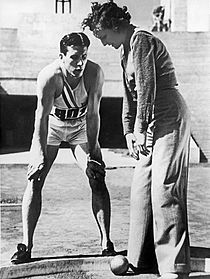Glenn Morris facts for kids

Morris and Leni Riefenstahl in 1936
|
|||||||||||
Quick facts for kids Personal information |
|||||||||||
|---|---|---|---|---|---|---|---|---|---|---|---|
| Born | June 18, 1912 Simla, Colorado, U.S. |
||||||||||
| Died | January 31, 1974 (aged 61) Palo Alto, California, U.S. |
||||||||||
| Alma mater | Colorado State | ||||||||||
| Height | 1.88 m (6 ft 2 in) | ||||||||||
| Weight | 84 kg (185 lb) | ||||||||||
| Military career | |||||||||||
| Allegiance | |||||||||||
| Service/ |
|||||||||||
| Unit | Pacific Theater | ||||||||||
| Battles/wars | World War II | ||||||||||
| Sport | |||||||||||
| Sport | Athletics | ||||||||||
| Event(s) | Decathlon | ||||||||||
| Club | Denver Athletic Club | ||||||||||
| Achievements and titles | |||||||||||
| Personal best(s) | 100 m – 10.6 (1936) 400 m – 49.4 (1936) 110 mH – 14.6 (1936) 400 mH – 544 (1934) LJ – 6.97 m (1936) SP – 14.45 m (1936) DT – 43.10 m (1936) JT – 56.06 m (1936) Decathlon – 7254 (1936) |
||||||||||
|
Medal record
|
|||||||||||
Glenn Edgar Morris (June 18, 1912 – January 31, 1974) was a famous American track and field athlete. He is best known for winning a gold medal in the decathlon event at the 1936 Summer Olympics in Berlin. During these games, he set new world and Olympic records. Besides being an amazing athlete, Glenn also played American football and even acted in a movie, playing the role of Tarzan.
Contents
Early Life and Athletic Beginnings
Glenn Morris was born on a farm near Simla, Colorado. He was the second of seven children in his family. From a young age, it was clear he was a natural athlete. In high school, he set a record in the 220-yard hurdles that lasted for 40 years!
In 1930, Glenn went to Colorado Agricultural College, which is now called Colorado State University. There, he became a star in many sports. He was even named an All-American in track and field. After graduating in 1934, he started training for the decathlon. He hoped to compete in the 1936 Olympics.
Olympic Glory in 1936
Glenn Morris showed his incredible talent at the U.S. Olympic trials for the 1936 Games. He set a new world record with 7,880 points. This earned him the nickname "the nation's new Iron Man" from Newsweek magazine.
At the Berlin Olympics, Glenn broke his own world record again! He scored 7,900 points in the decathlon, also setting a new Olympic record. People said that Adolf Hitler watched his entire competition without leaving his seat. After his win, Glenn received the James E. Sullivan Award as the top amateur athlete in the United States for 1936. He also worked briefly as a radio commentator for NBC.
From Athlete to Actor
Glenn Morris's success at the Olympics brought him a lot of fame. He even had a ticker-tape parade in New York City! In November 1937, a short film called "Decathlon Champion: The Story of Glenn Morris" was released. In this film, Glenn played himself, showing how he trained and won the decathlon.
After this, he became the fourth Olympic athlete to play the famous character Tarzan. He starred in just one Tarzan movie, Tarzan's Revenge (1938). While the movie itself got mixed reviews, Glenn was seen as a good Tarzan. After one more small film role, he decided to leave the movie business.
Life After Hollywood and War Service
In 1940, Glenn Morris played four games for the Detroit Lions in the National Football League (NFL). However, an injury ended his football career. He then worked as an insurance agent.
During World War II, Glenn served as an officer in the United States Navy. He was stationed in the Pacific and commanded special landing crafts. After the war, he faced some health challenges and spent time in a naval hospital.
Later Years and Legacy
After his military service, Glenn Morris worked in construction for many years. He also worked as a steel rigger for the United States Atomic Energy Commission. In his later life, he lived mostly in Menlo Park, California, and received care at veterans hospitals.
In 1967, Glenn was inducted into the Colorado Sports Hall of Fame. He was called "the world's greatest athlete." Even though he was too ill to attend, he donated his Olympic gold medal to the Hall. This medal, along with other items, was later given to Simla High School. The school now gives an annual "Glenn Morris Award" for great athletic and academic achievements. In 2011, the medal was donated to Colorado State University, where it is displayed in a building named in his honor.
Glenn Morris passed away in 1974 at the age of 61. He is remembered as an Olympic champion and a true all-around athlete.
Books About Glenn Morris
- In 2003, Mike Chapman wrote a book called The Gold and The Glory: The Amazing True Story of Glenn Morris, Olympic Champion and Movie Tarzan. It tells his life story with many photos.
- A novel titled Olympic Affair by Terry Frei was published in 2013. This book explores Glenn Morris's life and imagines a relationship he might have had with Leni Riefenstahl.
See also
 In Spanish: Glenn Morris para niños
In Spanish: Glenn Morris para niños

